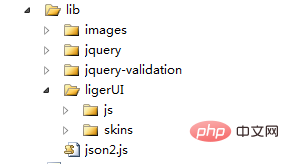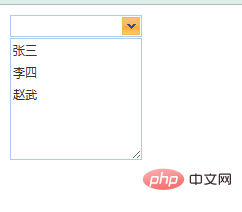What is jquery LigerUI?
jQuery LigerUI is a collection of UI plug-ins designed based on jQuery. Its core design goals are rapid development, simple use, powerful functions, lightweight, and easy to expand. Using the UI can help developers quickly create Friendly user interface.

The operating environment of this article: windows10 system, jquery 2.2.4, thinkpad t480 computer.
Related recommendations: "jQuery Tutorial"
jquery LigerUI rapid development UI framework
LigerUI is a UI framework based on jQuery , its core design goals are rapid development, simple use, powerful functions, lightweight, and easy to expand. Simple yet powerful, it is dedicated to quickly creating Web front-end interface solutions, which can be applied to .net, jsp, php and other web server environments.
LigerUI has the following main features:
Easy to use, lightweight
The controls are practical It has strong flexibility and large functional coverage, and can solve the design scenarios of most enterprise information applications
Rapid development, using LigerUI can reduce the amount of code significantly compared with traditional development
Easy to expand, including default parameters, form/table editor, multi-language support, etc.
-
Supports Java, .NET, PHP and other web servers
Supports IE6, Chrome, FireFox and other browsers
Open source, the source code framework level is simple and easy to understand.
How to use Jquery LigerUI
Before writing the specific use, let me briefly explain it. I also learned and sold it on the project. Feel free to correct me if I find anything wrong, thank you in advance. Okay, let’s get down to business. You can download a copy of the source code from the official website of LigerUI. We can find all the plug-ins of LigerUI in the lib/ligerUI directory as shown below:


You can see that the ligerUI directory mainly includes two directories, scripts and skins. All plug-ins of ligerUi are stored under JS. The Skin directory provides light green and gray. Different styles of skins, you can choose which skin to use according to your own preferences. The json2.js file is used to solve the problem that ie6 and ie7 do not support json objects (JSON.Parse(), and JSON.stringify()). If you need your program to support ie6 and ie7 browsers, you may need to change the reference script. Next, we use a simple example to illustrate:
<html xmlns="http://www.w3.org/1999/xhtml">
<head>
<title></title>
<link href="http://www.cnblogs.com/lib/ligerUI/skins/Aqua/css/ligerui-all.css" rel="stylesheet" type="text/css" />
<style type="text/css">
</style>
<script type="text/javascript"></script>
<script src="http://www.cnblogs.com/lib/ligerUI/js/core/base.js" type="text/javascript"></script>
<script src="http://www.cnblogs.com/lib/ligerUI/js/plugins/ligerComboBox.js" type="text/javascript"></script>
<script src="http://www.cnblogs.com/lib/ligerUI/js/plugins/ligerResizable.js" type="text/javascript"></script>
<script type="text/javascript">
$(function ()
{
$("#test1").ligerComboBox({
data: [
{ text: '张三', id: '1' },
{ text: '李四', id: '2' },
{ text: '赵武', id: '44' }
], valueFieldID: 'test3'
});
});
</script>
</head>
<body style="padding:10px">
<input type="text" id="test1" />
</body>
</html>The effect is as shown:

From the above code we can see that you first need to introduce the style corresponding to yours The ligerui-all.css file under the skin needs to import the jquery file and the js/core/base.js file. This file is just like the api file of jquery that you need to import when using jquery. It is a basic class. This is my personal understanding. But in the demo given by Ligerui, the layout page does not use this file but uses the /js/ligerui.min.js file. I tried it in a project. If these two are introduced at the same time, an error will occur, so I During use, in addition to the layout page, the base.js file is referenced in other screens before referencing other plug-ins of Ligerui. Secondly, which Ligerui controls are used on your current page, you must reference the corresponding js plug-in under js/plugins. For example, in the above example, the combobox control of ligerui is used, and the corresponding ligerComboBox.js plug-in must be referenced. The initialization of the control, such as the js part in the example code, needs to be placed in $(function(){...}). That is, the initialization methods of different controls are similar. For example, the initialization method of combox is $("..." ).ligerComboBox({...}), the initialization method of grid is ("...").ligerGrid({...}). As in the above example, the Data parameter is the control data source parameter, in ligerui All data sources can only be used in JSON format. For specific parameters, events, and methods of different plug-ins, please refer to the official API:
In actual projects, our data sources must be dynamically accessed from the database, as follows I posted the class I used in the project to convert DataTable into Json format. You can use it if you need it.
public class JsonOperation
{
/// <summary>
/// DataTable转换Json
/// </summary>
/// <param name="dtSource">转换数据源</param>
/// <param name="strJosonCols">Joson格式列</param>
/// <param name="strParCols">DataTable格式列</param>
/// <returns>Json字符串</returns>
public static string DataTableToJson(DataTable Source, string[] strJosonCols, string[] strParCols)
{
StringBuilder Json = new StringBuilder();
Json.Append("[");
if (Source.Rows.Count > 0)
{
for (int intRow = 0; intRow < Source.Rows.Count; intRow++)
{
Json.Append("{");
for (int intCol = 0; intCol < strJosonCols.Length; intCol++)
{
Json.Append(strJosonCols[intCol] + ":\"" + Source.Rows[intRow][strParCols[intCol]].ToString().Replace("\"","").Trim() + "\"");
if (intCol < strJosonCols.Length - 1)
{
Json.Append(",");
}
}
Json.Append("}");
if (intRow < Source.Rows.Count - 1)
{
Json.Append(",");
}
}
}
Json.Append("]");
return Json.ToString();
}
/// <summary>
/// DataTable转换Json
/// </summary>
/// <param name="dtSource">转换数据源</param>
/// <returns>Json字符串</returns>
public static string DataTableToJson(DataTable Source)
{
StringBuilder Json = new StringBuilder();
Json.Append("[");
if (Source.Rows.Count > 0)
{
for (int i = 0; i < Source.Rows.Count; i++)
{
Json.Append("{");
for (int j = 0; j < Source.Columns.Count; j++)
{
Json.Append(Source.Columns[j].ColumnName.ToString() + ":\"" + Source.Rows[i][j].ToString() + "\"");
if (j < Source.Columns.Count - 1)
{
Json.Append(",");
}
}
Json.Append("}");
if (i < Source.Rows.Count - 1)
{
Json.Append(",");
}
}
}
Json.Append("]");
return Json.ToString();
}
}For more programming-related knowledge, please visit: Programming Course! !
The above is the detailed content of What is jquery LigerUI?. For more information, please follow other related articles on the PHP Chinese website!

Hot AI Tools

Undresser.AI Undress
AI-powered app for creating realistic nude photos

AI Clothes Remover
Online AI tool for removing clothes from photos.

Undress AI Tool
Undress images for free

Clothoff.io
AI clothes remover

Video Face Swap
Swap faces in any video effortlessly with our completely free AI face swap tool!

Hot Article

Hot Tools

Notepad++7.3.1
Easy-to-use and free code editor

SublimeText3 Chinese version
Chinese version, very easy to use

Zend Studio 13.0.1
Powerful PHP integrated development environment

Dreamweaver CS6
Visual web development tools

SublimeText3 Mac version
God-level code editing software (SublimeText3)

Hot Topics
 1662
1662
 14
14
 1419
1419
 52
52
 1312
1312
 25
25
 1262
1262
 29
29
 1235
1235
 24
24
 Detailed explanation of jQuery reference methods: Quick start guide
Feb 27, 2024 pm 06:45 PM
Detailed explanation of jQuery reference methods: Quick start guide
Feb 27, 2024 pm 06:45 PM
Detailed explanation of jQuery reference method: Quick start guide jQuery is a popular JavaScript library that is widely used in website development. It simplifies JavaScript programming and provides developers with rich functions and features. This article will introduce jQuery's reference method in detail and provide specific code examples to help readers get started quickly. Introducing jQuery First, we need to introduce the jQuery library into the HTML file. It can be introduced through a CDN link or downloaded
 How to use PUT request method in jQuery?
Feb 28, 2024 pm 03:12 PM
How to use PUT request method in jQuery?
Feb 28, 2024 pm 03:12 PM
How to use PUT request method in jQuery? In jQuery, the method of sending a PUT request is similar to sending other types of requests, but you need to pay attention to some details and parameter settings. PUT requests are typically used to update resources, such as updating data in a database or updating files on the server. The following is a specific code example using the PUT request method in jQuery. First, make sure you include the jQuery library file, then you can send a PUT request via: $.ajax({u
 In-depth analysis: jQuery's advantages and disadvantages
Feb 27, 2024 pm 05:18 PM
In-depth analysis: jQuery's advantages and disadvantages
Feb 27, 2024 pm 05:18 PM
jQuery is a fast, small, feature-rich JavaScript library widely used in front-end development. Since its release in 2006, jQuery has become one of the tools of choice for many developers, but in practical applications, it also has some advantages and disadvantages. This article will deeply analyze the advantages and disadvantages of jQuery and illustrate it with specific code examples. Advantages: 1. Concise syntax jQuery's syntax design is concise and clear, which can greatly improve the readability and writing efficiency of the code. for example,
 jQuery Tips: Quickly modify the text of all a tags on the page
Feb 28, 2024 pm 09:06 PM
jQuery Tips: Quickly modify the text of all a tags on the page
Feb 28, 2024 pm 09:06 PM
Title: jQuery Tips: Quickly modify the text of all a tags on the page In web development, we often need to modify and operate elements on the page. When using jQuery, sometimes you need to modify the text content of all a tags in the page at once, which can save time and energy. The following will introduce how to use jQuery to quickly modify the text of all a tags on the page, and give specific code examples. First, we need to introduce the jQuery library file and ensure that the following code is introduced into the page: <
 Use jQuery to modify the text content of all a tags
Feb 28, 2024 pm 05:42 PM
Use jQuery to modify the text content of all a tags
Feb 28, 2024 pm 05:42 PM
Title: Use jQuery to modify the text content of all a tags. jQuery is a popular JavaScript library that is widely used to handle DOM operations. In web development, we often encounter the need to modify the text content of the link tag (a tag) on the page. This article will explain how to use jQuery to achieve this goal, and provide specific code examples. First, we need to introduce the jQuery library into the page. Add the following code in the HTML file:
 How to remove the height attribute of an element with jQuery?
Feb 28, 2024 am 08:39 AM
How to remove the height attribute of an element with jQuery?
Feb 28, 2024 am 08:39 AM
How to remove the height attribute of an element with jQuery? In front-end development, we often encounter the need to manipulate the height attributes of elements. Sometimes, we may need to dynamically change the height of an element, and sometimes we need to remove the height attribute of an element. This article will introduce how to use jQuery to remove the height attribute of an element and provide specific code examples. Before using jQuery to operate the height attribute, we first need to understand the height attribute in CSS. The height attribute is used to set the height of an element
 Understand the role and application scenarios of eq in jQuery
Feb 28, 2024 pm 01:15 PM
Understand the role and application scenarios of eq in jQuery
Feb 28, 2024 pm 01:15 PM
jQuery is a popular JavaScript library that is widely used to handle DOM manipulation and event handling in web pages. In jQuery, the eq() method is used to select elements at a specified index position. The specific usage and application scenarios are as follows. In jQuery, the eq() method selects the element at a specified index position. Index positions start counting from 0, i.e. the index of the first element is 0, the index of the second element is 1, and so on. The syntax of the eq() method is as follows: $("s
 How to tell if a jQuery element has a specific attribute?
Feb 29, 2024 am 09:03 AM
How to tell if a jQuery element has a specific attribute?
Feb 29, 2024 am 09:03 AM
How to tell if a jQuery element has a specific attribute? When using jQuery to operate DOM elements, you often encounter situations where you need to determine whether an element has a specific attribute. In this case, we can easily implement this function with the help of the methods provided by jQuery. The following will introduce two commonly used methods to determine whether a jQuery element has specific attributes, and attach specific code examples. Method 1: Use the attr() method and typeof operator // to determine whether the element has a specific attribute




